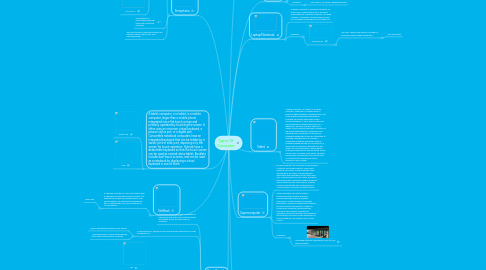Types Of Computer
da Minjoo Kim


1. A tablet computer, or a tablet, is a mobile computer, larger than a mobile phone integrated into a flat touch screen and primarily operated by touching the screen. It often uses an onscreen virtual keyboard, a passive stylus pen, or a digital pen. Convertible notebook computers have an integrated keyboard that can be hidden by a swivel joint or slide joint, exposing only the screen for touch operation. Hybrids have a detachable keyboard so that the touch screen can be used as a stand-alone tablet. Booklets include dual-touch screens, and can be used as a notebook by displaying a virtual keyboard in one of them.
1.1. Galaxy Tab
1.2. iPad
2. Game Console
2.1. A game console is a PC that is designed to play games and it has some features which exceed the quality of other types of computer.
2.2. Some features of a game console which exceed the quality of other computers are:
2.2.1. -screen that displays graphics very quickly.
2.2.2. -large hard disk for saving games;gamers often have a large number of games.
2.3. A desktop may have better specifications than a game console but it is likely to be more expensive. Examples of game consoles are :
2.3.1. Wii
2.3.2. Ps3
2.3.3. Xbox 360
2.3.3.1. Nintendo Ds
3. Smarphone
3.1. Examples
3.1.1. Samsung Galaxy S3
3.1.2. HTC One X
3.2. Smartphone is a mobile phone that has advanced computing capability
3.3. The most common operating systems are Google Android, Apple's iOS, and Samsung's Bada
4. NetBook
4.1. A netbook computer is a very small laptop that is optimized for internet and email access. It is intended to be light and portable with a long lasting battery. For example the Packard Bell dot S2 netbook has a 10.1 inch screen and a 10 hour battery.
4.1.1. New node
5. Personal Digital Assistant
5.1. A hand-held computer or Personal Iligital Assistant (PDA) or palmtop can lit in onc hand or in your pocket, but it is too small for general work. A PDA usually has a touch-sensitive screen. Although POAs can be temporarily attached to a keyboard. you cannot comfortably type a long docllment into Cl PUA, A smart phone is a mobile phone with the functions ofa PDA, Hand- held computing devices can perform a range or activities such flS personal record-keeping and satellite navigation.
6. Laptop/Notebook
6.1. A laptop computer is a personal computer for mobile use. A laptop has most of the same components as a desktop computer, including a display, a keyboard, a pointing device such as a touchpad and speakers into a single unit
6.2. Examples
6.2.1. Mac Book Air
6.2.1.1. The term "laptop" can refer to a number of classes of small portable computers
6.2.1.1.1. Full size laptop
7. Tablet
7.1. A tablet computer, or a tablet, is a mobile computer, larger than a mobile phone or personal digital assistant, integrated into a flat touch screen and primarily operated by touching the screen rather than using a physical keyboard. It often uses an onscreen virtual keyboard, a passive stylus pen, or a digital pen. The term may also apply to a variety of form factors that differ in position of the screen with respect to a keyboard. The standard form of tablet does not have an integrated keyboard but may be connected to one with a wireless link or a USB port. Convertible notebook computers have an integrated keyboard that can be hidden by a swivel joint or slide joint, exposing only the screen for touch operation. Hybrids have a detachable keyboard so that the touch screen can be used as a stand-alone tablet. Booklets include dual-touchscreens, and can be used as a notebook by displaying a virtual keyboard in one of them.
8. Mainframe
8.1. Mainframe computers are large super computers normally used by large corporations and the government. It is extremely fast and support a lot of workstations and network. They can be used to monitor a lot of computers.
8.1.1. An example of a mainframe computer is the ibm eServer zSeries 890 know as the baby shark.
8.1.1.1. eServer zSeries 890
9. Supercomputer
9.1. A supercomputer is a computer at the frontline of current processing capacity, particularly speed of calculation. Supercomputers were introduced in the 1960s at Cray Research. While the supercomputers of the 1970s used only a few processors, in the 1990s, machines with thousands of processors began to appear and by the end of the 20th century, massive supercomputers with tens of thousands of "off-the-shelf" processors became common.
9.2. Supercomputers are used for highly complicated tasks such as problems including quantum physics, weather forecasting, climate research, oil and gas exploration, molecular modelling (computing the structures and properties of chemical compounds, biological macromolecules, polymers, and crystals), and physical simulations (such as simulation of airplanes in wind tunnels, simulation of the detonation of nuclear weapons, and research into nuclear fusion).
9.3. Examples:
9.3.1. Oak Ridge National Laboratory's Cray XT5-HE supercomputer
10. Servers
10.1. In most common use, a server is a physical computer dedicated to running one or more services to serve the needs of the users of other computers on the network. Depending on the computing service that it offers, it could be a database server, file server, mail server, print server, web server, gaming server, etc.
10.2. Servers often provide essential services across a network, either to private users inside a large organization or to public users via the Internet.
10.3. Examples
10.3.1. Mail servers, file servers, database servers
